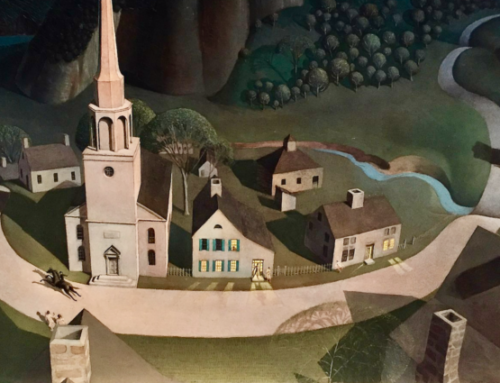There are few places in the world where I would rather take a vacation than Tuscany. Here are the birthplaces not only of Giotto, Leonardo, and Michelangelo, but the city of Dante, the heartland of popes, princes, and presidents. A visit to this blessed land immerses one in the history, art, cuisine, and culture of Christendom.
 There are few places in the world where I would rather take a vacation than Tuscany. The scholar and educator Michael Aeschliman and his wife Lynn occupy a hilltop farm called Podere Capitignano. Lynn has converted the farm buildings into holiday apartments. Each has stunning views across the Mugello Hills of Northeast Tuscany. Adjacent to Capitignano is the ancient Romanesque country church dedicated to Saint Cresci, an early Christian martyr who was beheaded nearby. Also embedded in the countryside are the remains of the pre-Christian peoples—not only the Romans, but the Etruscans before them.
There are few places in the world where I would rather take a vacation than Tuscany. The scholar and educator Michael Aeschliman and his wife Lynn occupy a hilltop farm called Podere Capitignano. Lynn has converted the farm buildings into holiday apartments. Each has stunning views across the Mugello Hills of Northeast Tuscany. Adjacent to Capitignano is the ancient Romanesque country church dedicated to Saint Cresci, an early Christian martyr who was beheaded nearby. Also embedded in the countryside are the remains of the pre-Christian peoples—not only the Romans, but the Etruscans before them.
I first visited Capitignano in 2017 as part of a retreat for leaders of classical schools organized by the Institute for Catholic Liberal Education. I’ve been back twice now for private vacations with family members. From a base at Capitignano one can make day trips to Florence, Cortona, Pisa, Lucca—all the choice locations of Tuscany, but there is something deeper happening in these hills than simply playing the tourist in Italy, enjoying fine food and ancient frescoes.
In a lecture to our group, Professor Aeschliman spoke about the rich legacy of Catholic art in the area. Each town and region has its own wine, cheese, and special cuisine, but he noted that each region also has its own Duomo (cathedral) and its own Madonna. Images of the Mother of God reside in the roadside shrines and in shop windows. Portrayals of the Annunciation are especially prevalent. Each church, it seems, features a carved tableau, a fresco, a painting, or mosaic portraying the intimate and cosmic meeting of Gabriel and the Virgin. The Lady Chapel of each cathedral or parish church is a focal point of devotion, art, and attention.
Aeschliman pondered the significance, musing that it was as if the artists understood at a fundamental level the link among the life on the land—the farms and vineyards of Tuscany—the production of art, and the fecundity of the incarnation. Part of the whole is also the dramatic history of Tuscany. Here are the birthplaces not only of Giotto, Leonardo, and Michelangelo, but the city of Dante, the heartland of popes, princes, and presidents. It was all connected, Aeschliman reasoned, and a visit to this blessed land immerses one in the history, art, cuisine, and culture of Christendom.
During my first visit to Capitignano, I was inspired to write about a dozen poems. When I commented on this surprising and sudden flash of creativity my hosts observed, “Yes, this land continues to inspire. Many visitors suddenly take up painting or drawing, write poetry or stories.”
One of the poems captured the core idea of Aeschliman’s lecture and his contemplative immersion in this most blessed landscape.
Mugello Hills
These mountains are no different than the rest.
These wooded hills and valleys are not strange.
There’s no reason to claim they are the best
or superior to any other range.
And yet there’s something deeper—something more
as if some ancient, pagan spirit stalks
these hills unseen. Its as if, at the core,
of this landscape the whole of history walks.
On this hill, an Etruscan holy ground,
there a temple to Asclepius stood.
In every town relics of Rome are found
and churches stand where martyrs shed their blood.
Here the warring factions of Florence fought
There Michelangelo and Raphael vied
Here Leonardo and Albertus taught
and Mussolini’s armies fought and died.
The professor believes that Tuscan art
somehow captures this sense of mystery.
It has Annunciation at its heart—
the Incarnation locked in history.
In other words, at a fixed point in time
the meaning and the material realm were merged.
the Word and the World began to rhyme
as into flesh the Universal surged.
That may explain why history and these hills seem one.
Every ruin and bone, every relic and stone,
are alive, not dead. They thrive. They are not set.
Because the angel and the girl are met.
The Imaginative Conservative applies the principle of appreciation to the discussion of culture and politics—we approach dialogue with magnanimity rather than with mere civility. Will you help us remain a refreshing oasis in the increasingly contentious arena of modern discourse? Please consider donating now.
The featured image, uploaded by Radek Hloch, is a photograph of the landscape of Tuscany with fields and hills. This file is licensed under the Creative Commons Attribution-Share Alike 4.0 International license, courtesy of Wikimedia Commons.







Beautifully written! The pictures alone of the Tuscany landscapes speak. The description you have written only intensify my desire to travel to these historic and religious sites. A pilgrimage and retreat.